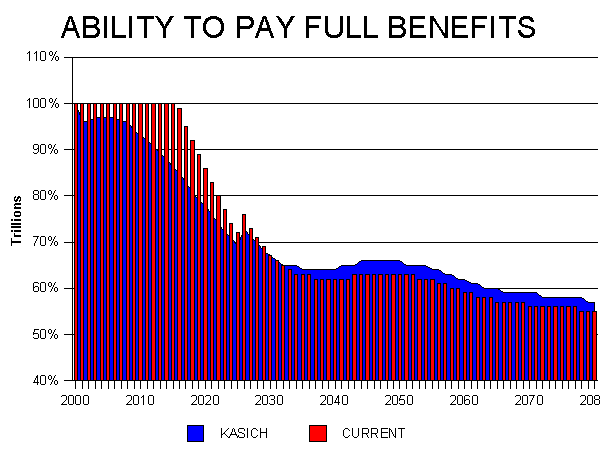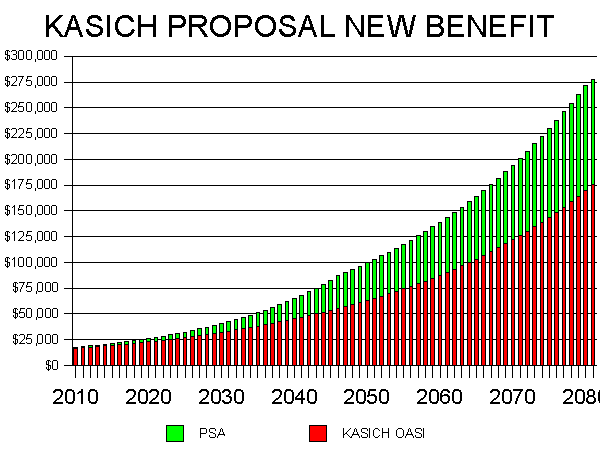
Home Page
Kasich's Social Security Plan
October 16, 2000
Kasich proposes to make two changes to Old Age Survivors Insurance program. It is his assertion these changes will make OASI solvent for all generations.
Step A is to change the replacement factor calculation. Currently the replacement factor is based on the change in the Average US wage. Kasich proposes basing the replacement rate on inflation of the Consumer Price Index (CPI). This would effect those currently under 55.
Step B is to allow those currently under 55 to contribute to Private Savings Account (PSA). The participant in the PSA would be allowed to divert 2.5% up to $30,000 to a PSA Account and up to 1% above this to $72,600.
The premise of this proposal is Wage Growth is increasing the future cost of OASI beyond the means of revenue growth. By changing the OASI formula and using inflation in the calculation of the replacement rate, the growth in future OASI benefits will be slowed. This is in effect a benefit cut for those affected..
To offset the benefit cut, Kasich proposes PSA's as compensation to the worker for reduced benefits. Will these combined changes meet the objective of making OASI Solvent in the future?
Summary
Kasich reduces the OASI revenue by over 20% with the diversion to PSA accounts. The first birth year affected by the changes in the replacement rate sees a 16% benefit reduction from the current projected OASI benefit. This particular worker will have paid in most of their lives without the benefit of a PSA account. It is natural this worker would pay the highest price.
The combined PSA and Kasich OASI benefits equates to a reduction of about 16 percent for those who are currently 55 and goes positive for those who are currently 28.
The problem with the Kasich proposal is OASI currently earns 6.9% on all surpluses but only pays the worker a return of 2 to 3%. One way to look at OASI is as a money broker. By diverting 2.5% to PSA, there is no longer a surplus from which to leverage future benefits. If the PSA earns 6.9%, it is in effect increasing the workers pull of money, while reducing OASI's working capital.
The net effect of the Kasich proposal is it does not eliminate the insolvency of OASI.
Analysis
To begin the analysis:
Wage growth was held constant at 3.5%. Inflation was held constant at 2.9%. No change to employment is made (maintains the same work force as a percent of potential workers). The PSA account earns 7%.
Checks
Kasich's table shows a cpi in 2070 of about 970. The current cpi is 173.18 (projected for 2000). This means Kasich has assumed an average yearly inflation rate of 2.49% for 70 years. This might happen, but it is doubtful. A more conservative number would be closer to 3%. The cpi in 1951 was 26.5 and in 1999 was 168.3 for a yearly rate of 3.93% over this time frame.
Kasich also predicts the OASI benefits to be those listed below by decades.
| COMPARISON OF CURRENT OASI BENEFIT TO KASICH PROJECTED CURRENT BENEFIT | |||
| YEAR | CURRENT OASI | KASICH OASI | DELTA |
| 2010 | $21,153 | $18,192 | 14% |
| 2020 | $30,559 | $27,408 | 10% |
| 2030 | $43,790 | $41,236 | 6% |
| 2040 | $61,771 | $62,232 | -1% |
| 2050 | $87,134 | $93,912 | -8% |
| 2060 | $122,911 | $141,708 | -15% |
| 2070 | $173,378 | $213,840 | -23% |
This is a bit odd in that the delta between my computer model OASI's benefit and Kasich projections for Current OASI benefits differ greatly. The reason is Kasich makes the common mistake of trying to back into the OASI benefit from Social Security's output. This normally is done by dividing the total OASI benefits by the number of beneficiaries to obtain the average OASI benefit for a particular year. There is just one problem with doing this. Each succeeding cohorts initial OASI benefit is normally larger than current and previously retired benefits. As more new retirees join the ranks of retirees, the increase is non linear which is what we are seeing.
In 2010, Kasich has diluted the initial OASI benefit by all the current retiree benefits which will reduce the value. When you add in wage growth (exponential growth) and COLA (exponential growth) together, you get a gradient It could also be Kasich has assumed a higher wage growth factor than the 3.5% I use.
However, there is one large discontinuity in all of this. Kasich's Proposal uses inflation as the method, of calculating the replacement factor, in the OASI benefit formula. Assuming a smaller inflation value than I have (2.9%) will reduce the initial OASI benefit even more. Therefore, Kasich's proposal has at least one major flaw in its presentation. This flaw actually effects the most critical variable in his proposal, which is future OASI benefits.
Yet there is another discontinuity in Kasich's proposal. If we assume a higher wage growth which would not affect benefits of those under 55 now, it would increase OASI revenues. However, Kasich presents a chart showing those currently under age 28 to have a combined PSA and OASI benefit greater than their projected Current OASI benefit. Increasing the Wage growth would make it extremely difficult for a combined PSA and OASI benefit to be greater than current projected OASI benefits.
Assuming the same 2.49% inflation as Kasich did, OASI still goes insolvent. Kasich's plan
does
reduce the unfunded liability present value to about $7.5 Trillion which in essence reduces it by
32%. As you will be able to see from the charts below, Kasich's proposal does very little to effect
the outcome of OASI.

The Kasich proposal creates PSA's which
allow the worker to invest a portion of their
OASI tax into a private account. The
amount is 2.5% up to $30,000 of wages.
This chart shows the projected portion of a
workers future benefit. A large portion will
come from the PSA.
Table version
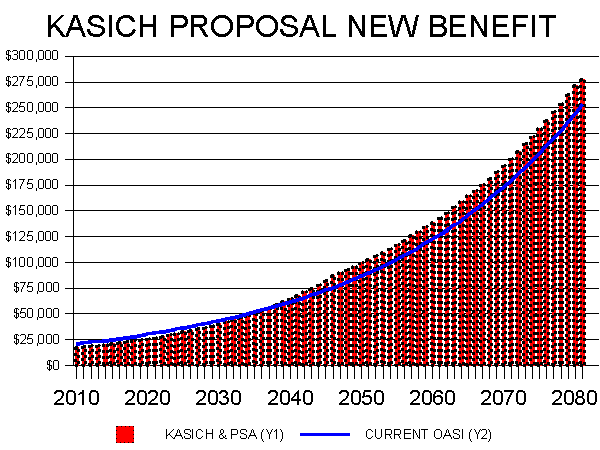
Comparing the current OASI benefit with
Kasich's proposal reveals a drop in benefits
for early participants, but becomes a better
deal for younger workers.
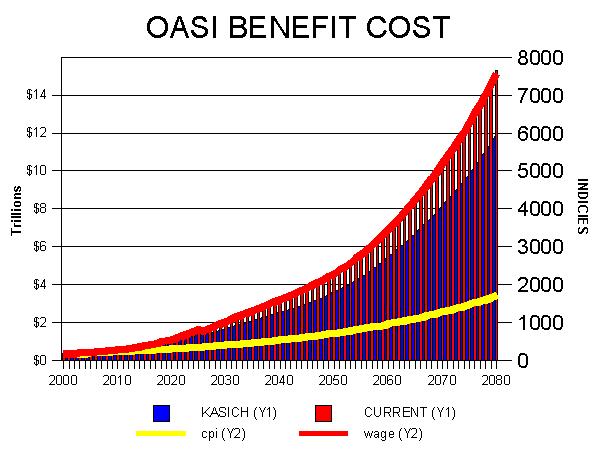
Kasich makes the assertion his plan reduces the future yearly cost of OASI. His plan does reduce future costs.
The current program with no changes has the future cost of benefits increasing at the same rate as OASI revenues. This would never bring solvency to the program.
However, Kasich's proposal only slows the
growth, but not to the level he thought it
would (inflation) The reason is population
growth is compounding the overall cost of
OASI.
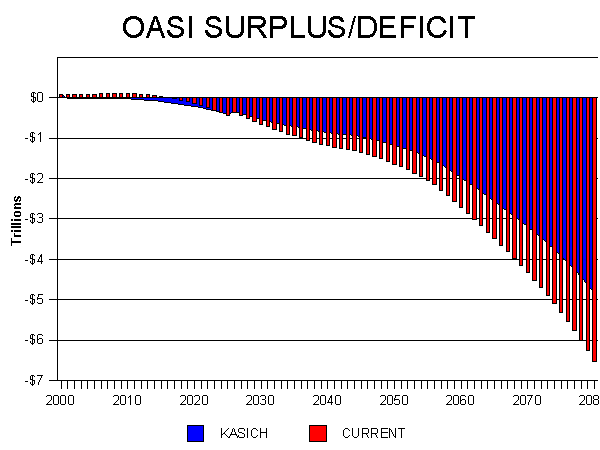
Kasich's plan causes an immediate deficit for OASI in the year it is implemented.
Kasich's proposal still has significant deficits
indefinitely.
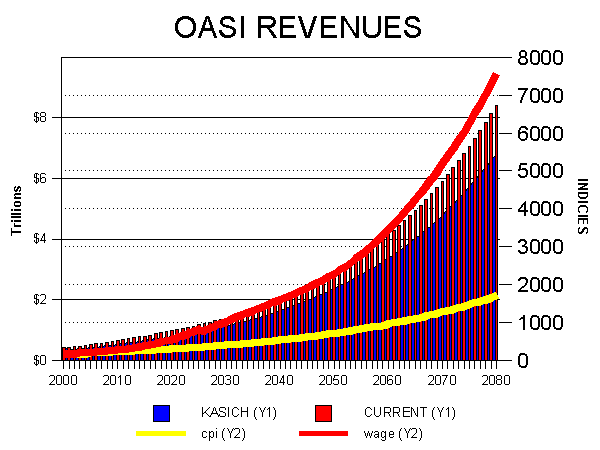
Kasich's OASI revenue drops due to the
diversion of OASI taxes to PSA's.
